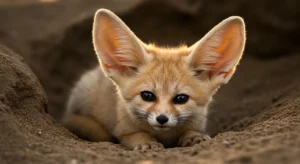Can Fennec Foxes Be Tamed?
The question of whether fennec foxes can be “tamed” is common among those captivated by their appearance. The answer is yes, they can be tamed to a certain extent, but it’s crucial to understand what “taming” means in this context and how it differs from true domestication.
Taming vs. Domestication
These terms are often used interchangeably but have distinct meanings:
- Taming: This refers to the process where an individual wild animal becomes accustomed to human presence and handling through prolonged exposure and positive interaction, usually starting from a young age. A tamed animal is essentially a wild animal that has lost its innate fear of humans but retains its species-specific instincts and behaviors. Taming happens within an animal’s lifetime.
- Domestication: This is a multi-generational process where a species undergoes genetic changes due to selective breeding by humans for desirable traits (like docility, reduced fear, specific physical characteristics). Domesticated animals (like dogs, cats, cattle) are genetically different from their wild ancestors and better suited for living closely with humans. This concept is well-documented in biology (Source: Wikipedia).
Fennec foxes kept as pets are **tamed, not domesticated.**
Fennec Fox Tamability
Fennec foxes, especially when acquired as young kits from reputable breeders and raised with consistent, positive human interaction, can become quite tame. They can learn to:
- Tolerate and sometimes seek out human presence.
- Accept gentle handling and petting (often on their own terms).
- Bond strongly with their primary caregivers.
- Learn simple routines and respond to their name.
- Walk on a harness and leash (with proper training and safety precautions).
The process of taming a fennec fox relies heavily on the owner’s effort and understanding.

Importance of Early Socialization
The key to achieving a reasonable level of tameness lies in the fennec fox socialization process. This critical period, primarily when they are young kits, involves:
- Frequent, gentle handling from a young age.
- Positive exposure to various sights, sounds, and environments.
- Introduction to different people (calmly and supervised).
- Building trust through positive reinforcement (treats, praise).
Fennecs that miss out on adequate early socialization are much more likely to remain fearful, skittish, and resistant to handling throughout their lives.
Limitations of Taming
Even a well-tamed fennec fox will retain its fundamental wild nature. Taming does not eliminate instincts like:
- Nocturnal Activity: They will still be most active at night.
- Digging: The urge to dig remains powerful.
- High Energy Levels: They require significant space and opportunity for exercise.
- Vocalization: They will still use their range of calls (screams, whines, chatters).
- Skittishness: They may always be easily startled by loud noises or sudden movements.
- Scent Marking: This instinct often persists despite training attempts.
- Fear Responses: When scared or stressed, they may revert to defensive behaviors like nipping or fleeing.
Individuality: Tameness levels vary greatly between individual foxes, even with similar upbringing.
Handling and Interaction
Tamed fennecs often tolerate handling but may not actively seek out cuddling like a lap dog or cat. Interaction is typically on their terms. Building a bond involves respecting their boundaries, engaging in play, and providing consistent care, rather than expecting constant physical affection.

Maintaining Wild Instincts
It’s crucial for owners to understand that taming does not create a domestic pet. They must manage the environment to accommodate the fox’s instincts safely and ethically, providing outlets for natural behaviors like digging and running, rather than trying to suppress them entirely.
Conclusion: Tamable, Not Domesticated
Yes, fennec foxes can be tamed through dedicated effort, particularly with early socialization and consistent positive interaction. They can learn to trust and bond with humans, accepting handling to varying degrees. However, they are not domesticated and will always retain their core wild instincts and behaviors. Potential owners must appreciate this distinction and be prepared to manage a high-energy, often skittish, and instinct-driven animal, rather than expecting a pet comparable to a dog or cat. Successful ownership hinges on understanding and respecting their wild nature, even in a tamed state.
Definitions of taming and domestication based on standard biological and ethological principles.





